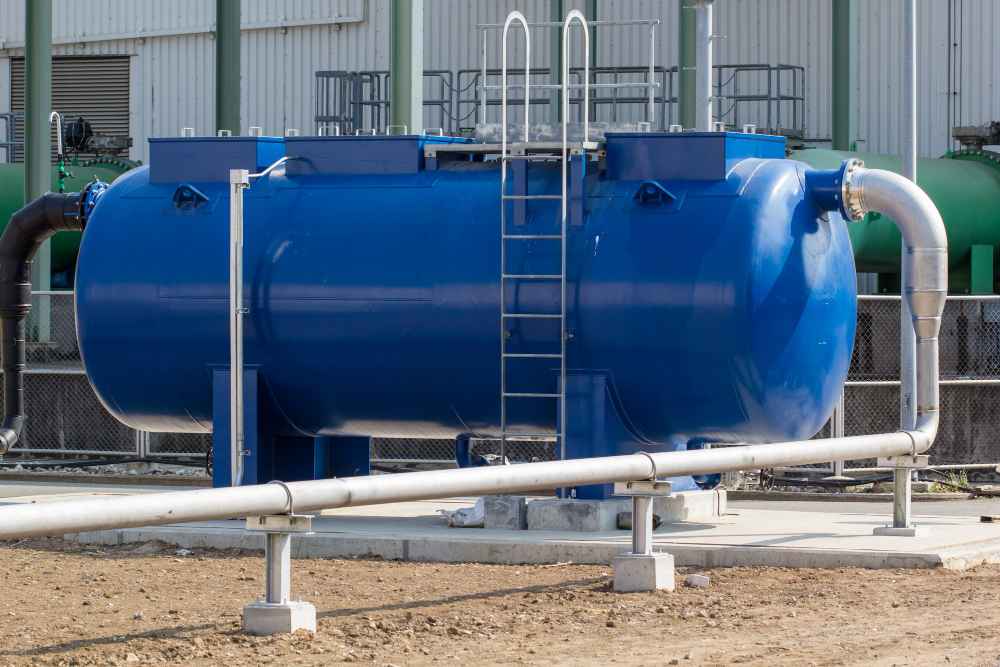Water enters a fuel tank through condensation, contaminated fuel, rainwater seepage, poor storage, or damaged seals. Temperature changes cause moisture in the air to condense inside the tank, while contaminated fuel or faulty filler caps can also let water in. Improperly sealed or outdoor fuel tanks are especially prone to water entry, leading to corrosion, fuel contamination, and engine problems if not addressed.
Finding water in your fuel tank can be one of the most frustrating and damaging problems for vehicle owners and machinery operators. Whether it’s a car, generator, or industrial fuel system, water and fuel do not mix. Even small amounts of water can cause performance issues, corrosion, and in severe cases, complete engine failure. Understanding where water in a fuel tank comes from, how it gets there, and what you can do to prevent it is essential for maintaining the health of your engine and fuel system.
Understanding the Problem: Why Water in a Fuel Tank is Dangerous
Before explaining how water enters the tank, it’s important to understand why it’s such a problem. Water contaminates fuel in two main ways, as free water (visible at the bottom of the tank) or as dissolved water (mixed invisibly within the fuel). Over time, both forms can cause serious issues.
Some of the most common consequences include:
- Corrosion of fuel lines and injectors, especially in diesel systems.
- Reduced engine performance due to poor combustion.
- Fuel filter blockages occur when water mixes with impurities or rust.
- Bacterial and fungal growth, particularly in diesel tanks, is promoted by water, which supports microbial contamination.
- Starting problems in cold conditions due to water freezing.
Now let’s look at how and why this happens.
Where Does Water in a Fuel Tank Come From?
The question “Where does water in a fuel tank come from?” has several answers. Water can enter your fuel system through multiple routes, some due to environmental factors and others due to human error. Here are the most common causes:
Condensation Inside the Tank
Condensation is by far the most common cause of water in a fuel tank. When the temperature outside fluctuates, especially during cold nights and warm days, moisture from the air inside the tank condenses on the inner walls. This water then drips down into the fuel.
Tanks that are left half empty are particularly vulnerable because more air space inside means more opportunity for condensation to form. Over time, these tiny droplets accumulate and settle at the bottom of the tank, creating a layer of water beneath the fuel.
To reduce condensation:
- Keep your fuel tank as full as possible, especially overnight or during cold weather.
- Store fuel in dry, temperature-stable environments.
Poor Fuel Quality or Contaminated Supply
Another common source of water in a petrol tank or diesel tank is contaminated fuel. Fuel can become tainted with water at multiple stages of its journey, from refinery storage tanks to transport tankers and even the filling station itself.
If a supplier’s fuel storage tank hasn’t been properly maintained or drained, water can accumulate at the bottom and mix with fuel during refuelling. This means that every time you fill up, a small amount of water could enter your vehicle’s tank.
That’s why it’s crucial to choose trusted fuel suppliers. Reputable companies like 123 Oil ensure that all storage systems are regularly inspected, drained, and filtered, reducing the risk of water contamination before the fuel ever reaches your tank.
3. Rainwater Seepage
Rainwater is another potential source of contamination. If your fuel filler cap is loose, cracked, or damaged, it allows water to seep in during heavy rain or while washing your car. Similarly, external fuel tanks that are exposed to outdoor elements are vulnerable to leaks around seals, vents, or caps.
Even a few drops entering repeatedly can cause a build-up of moisture that eventually forms a visible layer of water in the fuel.
To prevent this, always:
- Inspect the filler cap regularly for cracks or wear.
- Replace damaged seals immediately.
- Ensure outdoor fuel tanks are covered and weatherproofed.
Faulty Fuel Storage Practices
In homes, farms, or industrial sites that use fuel storage tanks, improper storage is a major cause of contamination. If tanks are stored directly on the ground, rainwater runoff or groundwater can enter through tiny cracks or vents.
Metal tanks that are not properly sealed or maintained can also develop corrosion over time, leading to leaks and allowing moisture to seep in.
Proper installation and regular maintenance checks are key to preventing these problems. Storing tanks under shelter or above ground can also help reduce exposure to rain and humidity.

Fuel System Breathing (Air Exchange)
Most modern fuel tanks have a venting system that allows air to move in and out as fuel levels change. Unfortunately, this also allows moisture-laden air to enter the tank. When temperatures drop, this moisture condenses into water droplets, gradually building up over time.
This is another reason why vehicles and storage tanks that sit unused for long periods are more prone to water contamination.
Human Error During Refuelling
Sometimes water gets into the tank simply through carelessness. For example, refuelling during rain, using open containers, or leaving the tank cap off during maintenance can all allow unwanted moisture to enter the fuel system.
Small mistakes like these can have long-term effects, especially if they go unnoticed.
Signs of Water in a Fuel Tank
Detecting water in a petrol tank or diesel system early can save you from serious damage. Here are some warning signs to look for:
- Rough engine idling or misfiring, Water disrupts the air-fuel mixture.
- Difficulty starting the engine, especially in cold weather.
- Sudden loss of power or stalling during acceleration.
- Corrosion or rust in fuel filters or tanks.
- Unusual white smoke from the exhaust.
- The fuel filter is clogging due to water mixing with sediment.
If you experience these symptoms, it’s important to inspect your tank or consult a mechanic immediately.
How to Remove Water from a Fuel Tank
If you suspect water contamination, don’t panic, there are several effective methods to remove it, depending on the severity:
Use a Fuel Additive or Water Remover
For small amounts of water, fuel additives or water dispersants can help. These chemicals bind with the water, allowing it to pass safely through the combustion process. Make sure to choose an additive compatible with your fuel type (petrol or diesel).
Drain the Tank
In severe cases, especially when free water is visible at the bottom, the only solution is to drain and clean the tank. This process involves:
- Removing all the fuel.
- Cleaning the inside of the tank.
- Replacing fuel filters.
- Refilling with clean, dry fuel.
Check and Replace Filters
Fuel filters often trap moisture and dirt. Replacing them regularly prevents these contaminants from reaching the engine.
Professional Cleaning Services
For large or industrial tanks, it’s best to use professional cleaning and inspection services. They use specialised equipment to test, remove, and prevent further contamination.
Preventing Water in a Fuel Tank
Once your tank is clean, prevention is key to keeping it that way. Here are some useful tips:
- Keep the tank full to reduce the amount of condensation space.
- Regularly inspect filler caps, seals, and vents.
- Use quality fuel suppliers who test for contamination.
- Avoid refuelling in rain or humid conditions.
- Drain storage tanks periodically to remove sediment and water build-up.
- Store fuel indoors or under cover whenever possible.
The Role of Water Detection in Modern Systems
Modern vehicles and fuel systems often include water sensors or separation filters that detect and trap moisture. Diesel engines, in particular, use water separators to protect injectors and pumps from corrosion. Regularly checking and draining these separators is vital for keeping your system running efficiently.
The Science Behind It: Why Water and Fuel Don’t Mix
Fuel, whether petrol or diesel, is hydrophobic, meaning it repels water. When water enters, it separates and sinks to the bottom because it’s denser. Over time, this layer of water begins corroding metal components and supports microbial growth, creating a sludge-like residue that clogs filters.
This microbial growth, known as diesel bug, thrives in the boundary between water and fuel, producing acids that damage tanks and injectors. Regular maintenance and monitoring can eliminate these risks.
Final Thoughts
So, how does water enter a fuel tank? The main culprits are condensation, contaminated fuel, rainwater seepage, poor storage, and human error. While some causes are unavoidable due to environmental conditions, most can be prevented with proper care and maintenance.
Keeping your fuel clean and water-free ensures smoother engine performance, reduces repair costs, and extends the lifespan of your equipment. By choosing reliable suppliers, monitoring tank conditions, and using fuel additives when necessary, you can protect your investment from unnecessary damage.
Frequently Asked Questions
Water can enter through condensation, contaminated fuel, rainwater seepage, or poor storage conditions.
Rough idling, hard starting, loss of power, and white smoke are common indicators.
It’s not recommended. Even small amounts can damage injectors and cause engine failure.
Use a fuel additive for minor contamination or have the tank drained and cleaned for severe cases.
Keep tanks full, check seals, use clean fuel, and store tanks in dry, protected areas.










